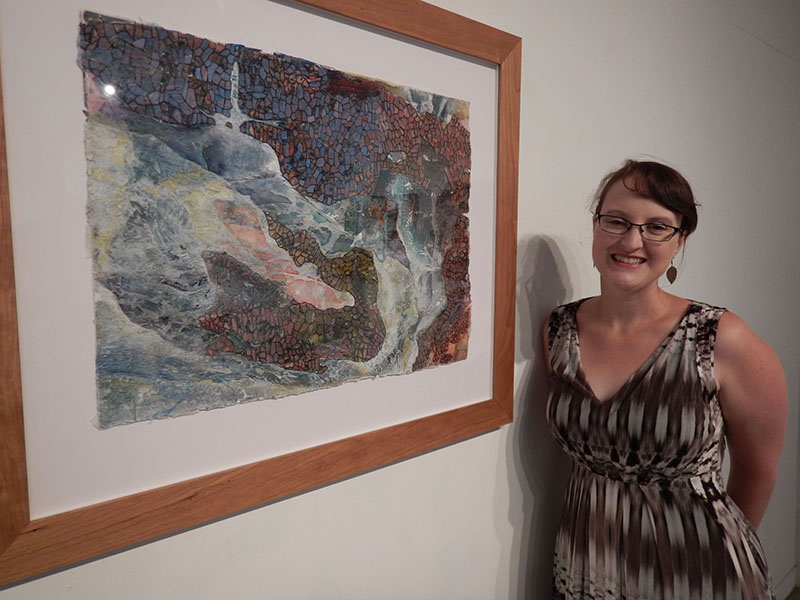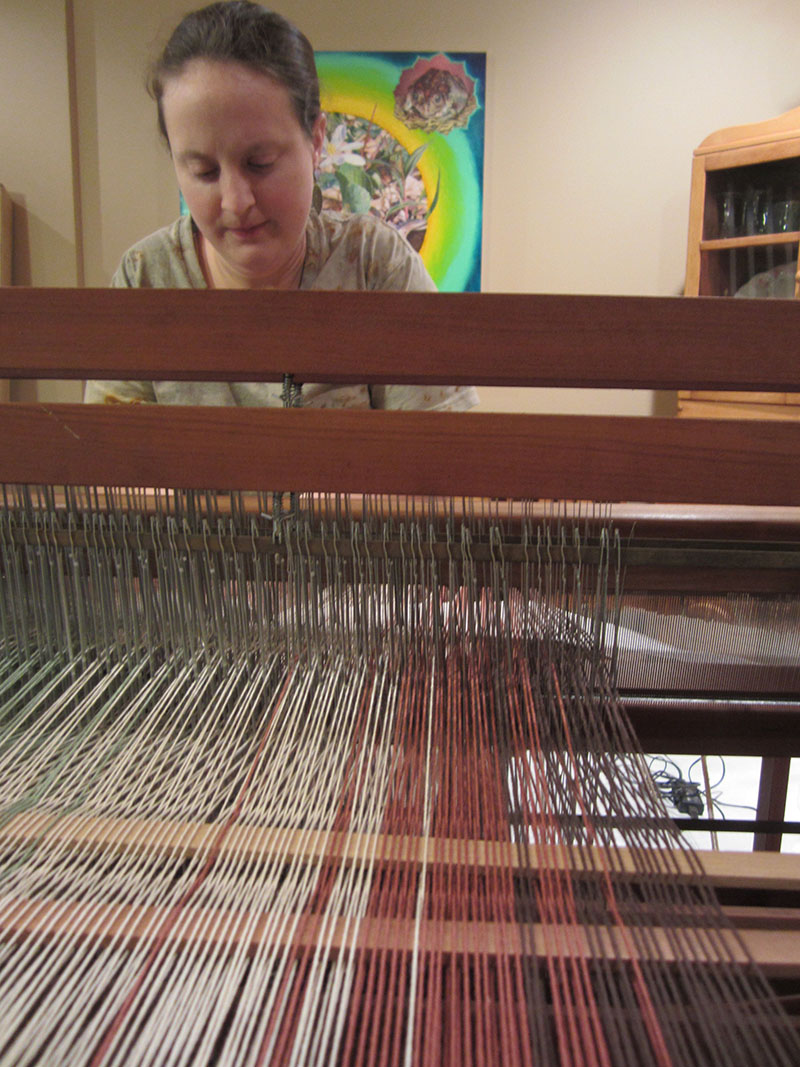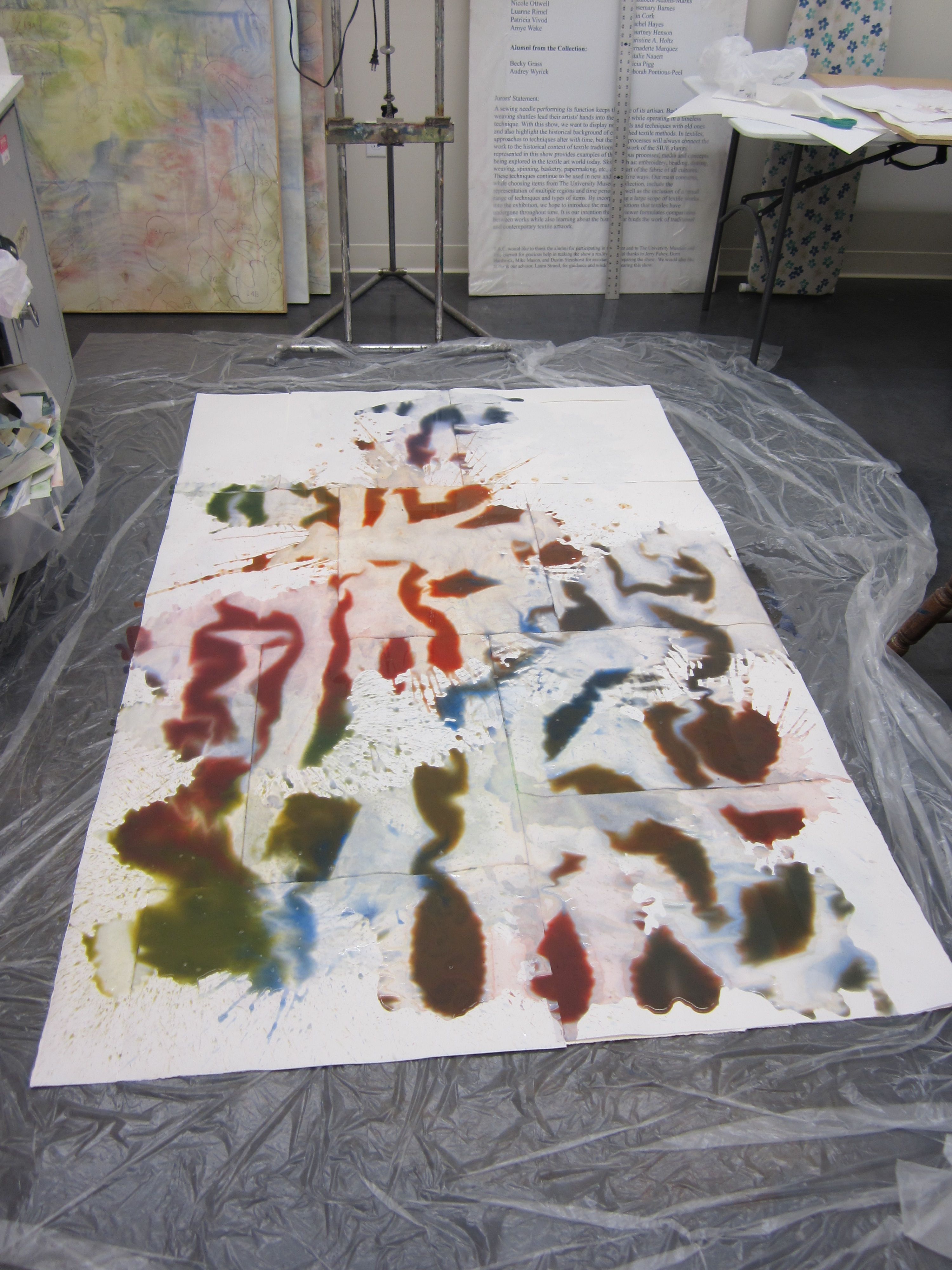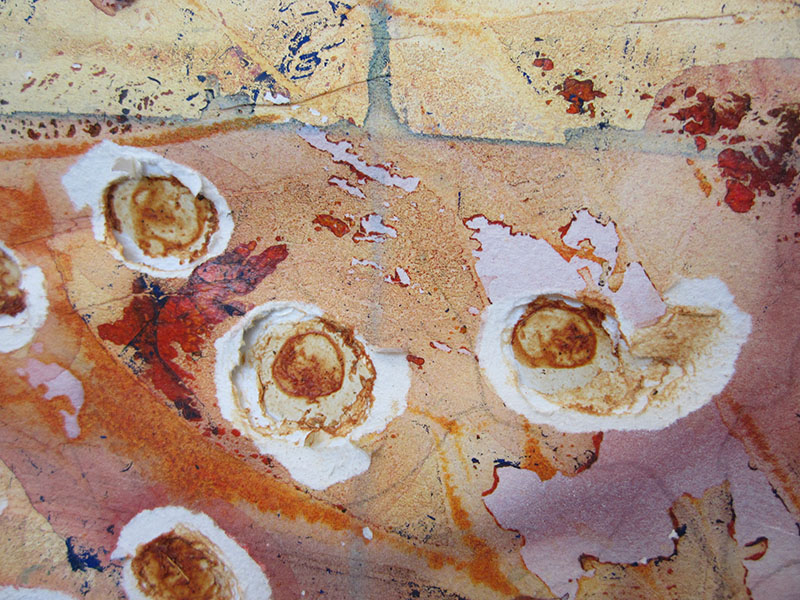Experiencing the mixed media work of Sarah Marjanovic is much luck encountering the artist herself. The warmth and natural beauty that invites you in is equally matched by the quiet strength that has come from deep commitment to her message, conservation, and a stunning range of skills. Both are easy to approach, but become harder to walk away from the more you learn about them. You may know her from the local artist group Comrades in Art, or from her recent participation in Giertz Gallery’s Around the Block III community exhibition, or perhaps, you’ve met her while donning her illustrator or graphic designer hats. But as I hope you will soon discover, Sarah Marjanovic is a rare breed of artist. As serious as the conservation issues that motivate her, she never fails to capture the wonder and beauty of the wild landscapes she first encountered as a child. Her singular style emerges from the continually evolving eco-technologies she employs. Talking with her, as I did amidst her preparation for two upcoming summer shows, is nothing short of a master class in artistic voice and process. Read on and be inspired.

Photo courtesy of Sarah Marjanovic.
Smile Politely: You’ve spoken and written about how your work is inspired by and connected to your own personal involvement with land conversation. I’d like to dig deeper into that connection. How did it begin? How did it impact your process and materials? What did it look like at first? And how has it evolved?
Sarah Marjanovic: My own personal involvement with land management began at a very early age, perhaps when I first went toddling along beside my mother in the woods and held onto one branch of a bush honeysuckle sapling and pulled, helping her remove that invasive species from our woodland. My early sketches are full of images of nature. At the end of my undergraduate degree, I investigated how farming and working outdoors would affect the faces of individuals. The results were very realistic portraits. Most likely that is the beginning of the thought of my intimate connection to the land being a catalyst for creating. Beginning in graduate school, I searched for ways to communicate the feeling of immersion and interconnection to the natural world.

Photo courtesy of Sarah Marjanovic.
Soon the figure became less and less significant to my art, and my work became less representational. My mark-making became aggressive and reflected the devastating change caused by invasive plants in the ecosystem. I even used raw botanical materials, gathered from the invaded and declining landscape, as tools for mark-making as well. Each artwork was focused on one piece of land where my family and I had worked to restore habitat. I found that my artworks could be categorized into two different series: Invasions series (exploring changes in landscape due to invasive exotic plants) and the Miniscule and Monumental series (exploring the interconnection of organisms in the natural world and the slippage of images between micro and macro). Today my pieces in the Invasions series are less focused on one particular natural area. Art in the Miniscule and Monumental series are now colorful and texturally intriguing.

Photo courtesy of Sarah Marjanovic.
SP: Did your work in fiber arts emerge out of this connection? Or had it been an area of interest all along?
Marjanovic: Fiber art has quite possibly been an interest all along. I became engaged with textiles during weaving classes as an undergraduate student. Weaving is very satisfying because the artist can see the textile come together as she or he works. The process can be meditative. Also I took a deep dive into studying and experimenting the production of dyes from botanical materials and the dyeing of natural fibers. My investigation in natural dyeing is on-going, and it is something I enjoy doing outdoors especially during the summer. The artworks are more light-hearted—more playful.
SP: When I think of your work, I’m reminded of McLaren’s notion that the medium is the message. So much of your work involves the creation of source materials, and ecologically sound ones at that. It seems daunting as well as freeing. What has the experience been like for you? And what advice might you give to mixed media artists wanting to incorporate preservation and conservation into their practices?
Marjanovic: Creating source materials is completely congruous with my involvement in land stewardship. My advice to mixed media artists with interest in preservation and conservation is to first become well-informed and then to truly experience land management. Consult published works about nature. Confer with experts in the Illinois Department of Natural Resources and the USDA Natural Resources Conservation Services. But, most importantly get outside and experience the outdoors. Perhaps, seek out those certain organizations which offer stewardship volunteerism, one such is the Grand Prairie Friends.

Photo courtesy of Sarah Marjanovic.
SP: How do you describe your style? How has it evolved? Who and what have been your biggest influences? And why?
Marjanovic: My style is not easily definable since it is evolving and often depends on the project. Textures, shifting perspectives and scale are significant in some of my abstract works of art… Also, I create very realistic renderings. My biggest influence stems from my family who are outdoor enthusiasts and hard-working farmers and conservationists. Their presence is everything. A selection of artists who have influenced my works greatly include Yang Yanping, Nancy Chu Woo, Morris Louis, Joan Hall, India Flint, and Newton and Helen Mayer Harrison, but I am likewise influenced by my wonderful colleagues of the group Comrade in Arts and by those (such as yourself, the author of this article) who have been in the trenches with me creating art with conviction and enthusiasm. My husband’s curiosity and joy for life influences me to keep wondering and investigating.
SP: You recently had the chance to speak about your work as part of the Giertz Gallery Around the Block III artist talk series. What were the main things you wanted the audience to know about the work you exhibited?
Marjanovic: The creating of art is such a vulnerable experience. I want the audience to know that my artworks are sincere and heartfelt. The development of the piece in the Giertz Gallery’s exhibit was especially significant in helping me cope with the pandemic. Thank you to everyone who took time to look at the exhibit and who watched the artist talk.
SP: What are some of the frequent questions you get about your work? What seems to resonate most with audiences? Or perhaps, what do you believe to be the biggest misconceptions about it?
Marjanovic: I am often asked about what processes I’ve used to create different pieces. My methods for mark-making include several forms such as hand-stitching, painting, collaging, and manipulating paper. A common complexity of merging media is that each medium has its own characteristics and involves some careful planning—getting them to work together in synergy is key.

Photo courtesy of Sarah Marjanovic.
SP: You are a triple threat artist. Mixed media, illustrator, and graphic designer. How do you balance it all? Do you find that these different ways of working ever inform each other? If so, how?
Marjanovic: Since most of my day is filled with digital media, I find that I really crave the tactile quality of working with my hands on mixed media artwork in the evenings. The directness of manipulating paper through stitching, sanding, collaging, or painting is revitalizing. Also, I see my interest in complex textural surfaces reflected in my digital work. I noticed this interest being expressed recently as I was working on a graphic by overlaying type onto a photo in such a way that amplified the texture underneath. While creating an illustration of a Blanding’s turtle, I found myself emphasizing the mottled coloration of the turtle’s shell. Finding balance between the three forms of art (mixed media, illustration, and graphic design) is not always easy. I try to identify things which prevent me from furthering my art practice so that I can work to remove those barriers. I find creating on a blank surface off-putting, so I prepare surfaces by producing several collages. It is great to have a few on hand for when I’m ready to start a new project or to switch to a different project. Finding balance is a continual exercise that yields success some days and exhaustion other days.

Photo courtesy of Sarah Marjanovic.
SP: What’s up next for you after Around the Block III?
Marjanovic: I am excited to have the opportunity to participate in two other juried exhibitions this summer. One exhibit is the 29th Cedarhurst Biennial exhibition at the Cedarhurst Center for the Arts in Mount Vernon, Illinois. The second exhibit is “Abstract Abstraction” at the St Louis Artist Guild in St Louis, Missouri.
See more of Sarah Marjanovic’s work on her website or follow her on Instagram.








